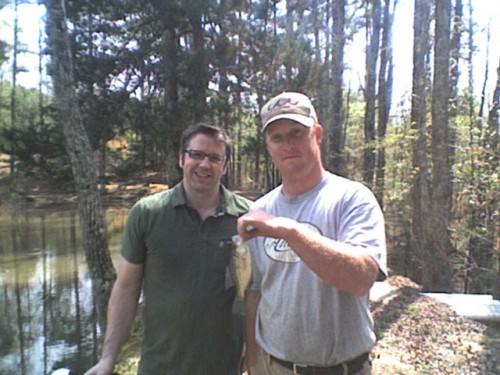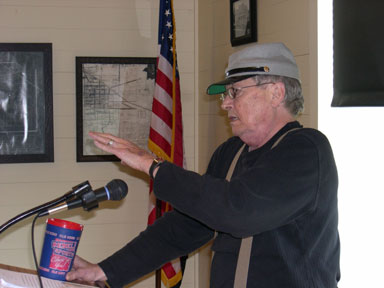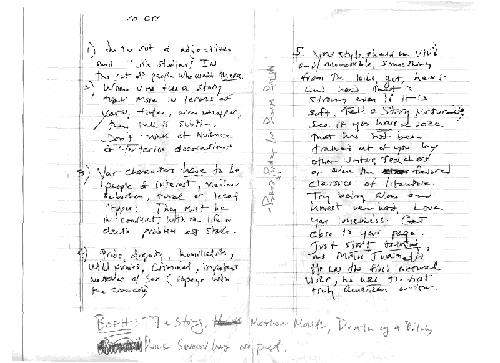The Nation Spring Books Issue…

On the origin of awesome beards.
…is on stands now. I haven’t seen a hard copy yet, but if you click over to their website the top story is an essay by William Deresiewicz, for whose critical writing I expressed much love in a previous post. Here’s a meaty little excerpt from “Adaptation: On Literary Darwinism.”
Human beings expend an enormous amount of energy doing things that don’t seem to have any survival value: singing, dancing, painting caves, decorating spears and, above all, telling stories. (Think how much time you spend consuming fictional narratives–novels, movies, TV shows–in one form or another.) The nascent field of Darwinian aesthetics seeks to account for the art-making impulse in evolutionary psychological terms. If art is a product of the mind, and the mind is a product of evolution, then art is a product of evolution. Again, as an intellectual project, this is perfectly valid. But there are also strong selection pressures pushing in the direction of such an approach. Evolutionary thinking is, at present, an aggressively expansive species within the academic world, a kind of emergent Homo sapiens outcompeting the old-school Neanderthals across a wide swath of intellectual territory. Having colonized the social sciences–where it has begun to displace the view, predominant throughout the twentieth century, that the mind is a highly malleable product of culture–it has now set its sights on the humanities, the last area of resistance.
TARGET: Shorts!
httpv://www.youtube.com/watch?v=AN35-NWUzWM
Spotted in attic where Gene goes to escape from “the kids” and “the wife,” probably: Target shorts. Pepsi Max in bottles?
Infinite Summer

Sentimental. Happy to be.
You’ve been meaning to do it for over a decade. Now join endurance bibliophiles from around the web as we tackle and comment upon David Foster Wallace’s masterwork, June 21st to September 22nd. A thousand pages1 ÷ 93 days = 75 pages a week. No sweat.
Ladies and gentlemen, let us make the summer of 2009 David’s.
The Oblivion Seekers by Isabelle Eberhardt
 I recently reread this tiny collection of stories by Isabelle Eberhardt, published by the great independent publisher, City Lights Books (click here to visit) . I originally read it in my mid-twenties when going through a massive Paul (primarily his short fiction) and Jane Bowles phase which culminated in my reading other authors Paul Bowles had translated, Eberhardt being one of them. READ MORE >
I recently reread this tiny collection of stories by Isabelle Eberhardt, published by the great independent publisher, City Lights Books (click here to visit) . I originally read it in my mid-twenties when going through a massive Paul (primarily his short fiction) and Jane Bowles phase which culminated in my reading other authors Paul Bowles had translated, Eberhardt being one of them. READ MORE >
Gary Indiana, Rudy Wurlitzer and YOU!

On May 28, worlds will collide as Gary Indiana and Rudy Wurlitzer converge on 192 Books in Chelsea, just south of my office. Two Dollar Radio has just put out Indiana’s The Shanghai Gesture, and is about to rerelease Wurlitzer’s Nog—a fevered dream which threatens to split our world in twain, if ever there was one (to paraphrase Scruffy). Now, I have not yet read either of these, but I have read books by these gentlemen (I use the term loosely. HEYOOOO!) before. Wurlitzer’s The Drop Edge of Yonder, which Two Dollar Radio put out last year, was rad. BMX rad, even (fist pound for the 1980s). And Indiana is a baaaddd man (to paraphrase Ali [or is it Mr. T?]). The upshot is, I suppose, that this will be a strange and surprising event the likes of which we haven’t seen since the Tunguska incident (nod to Pynchon).
May 20th, 2009 / 7:59 am
Down South with the Ghost of Larry Brown (guest posted by Kevin Sampsell)

Is it weird to cry over the death of a writer? When Larry Brown died just before Thanksgiving in 2004 at the age of 53, I remember seeing the news of it on a web site and involuntarily saying “Holy shit” out loud, even though no one else was around. I didn’t cry then but I wanted to, as if my tears would represent a show of respect or offer a thank you to the man who wrote many of my favorite short stories and novels. His writing was a beautiful streamlined machine, full of blunt emotion, a subtle trashy humor, and down-on-their-luck country boys, and hard southern women. With each book, Larry’s style got tighter, more muscular. Later novels like Joe and Fay conjure up names like Flannery O’Connor and adjectives like classic and cinematic. In 1994, I saw Larry read at Powell’s Books from his memoir, On Fire. Although he didn’t like to do the book tour circuit, and often drank too much while on the road (drinking is often the favorite pastime of his characters), he was on his best behavior and was soft-spoken and gentlemanly when I asked him to sign my books. Two years later, he came back to town for his powerful revenge novel, Father and Son. For some reason, I missed that reading, but I heard he was bleary-eyed drunk and read a rape scene before plopping down to sign books for the stunned audience.
The Brandon Book Crisis: A review

The Brandon Book Crisis (Muumuu House, 2009) by Brandon Scott Gorrell and Tao Lin
A paperback “thriller” about book design published May 25, 2009 in a limited edition of 150 numbered copies. 152 pages, 5.5″ x 7″, © Creative Commons, No Rights Reserved. Features 140+ pages of unedited Gmail chats, text messages, voicemails, and emails between Brandon Scott Gorrell, Tao Lin, and others.
The Brandon Book Crisis is, put simply, a book about the making of a book, which is not an entirely new postmodern conceit, if one thinks about the self-referential Pale Fire (Nabokov), Coming Soon! (John Barthes), or Lunar Park (Bret Easton Ellis), to name a few. ‘Edited,’ or rather, compiled by Brandon Scott Gorrell and Tao Lin, it consists of gmail chats (already aestheticized by Muumuu House), emails, and the occasional frantic text concerning the printing of Brandon Scott Gorrell’s During my nervous breakdown I want to have a biographer present — specifically, its fonts, colors, and unworkable files.
‘The Rough South of Larry Brown’
Thanks to Aaron Manning for sending over this wonderful clip from a feature length documentary on Larry Brown, including commentary on how he got started writing, and his early submission/rejection process: how can you not love this man?
Damn I want the rest of this.


